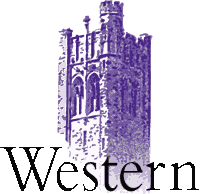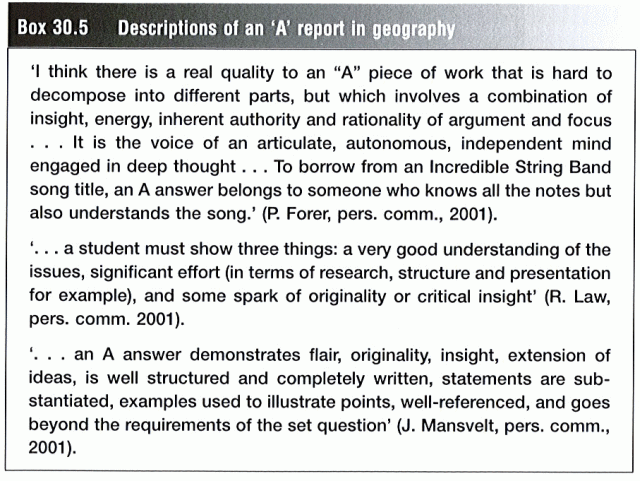
Associate Professor - UWO Geography
Geography 9099 - Qualitative Methods in Social Geography

| GEOGRAPHY 9099 |
| News |
| Description |
| Contact |
| Evaluation |
| Readings |
| Handouts |
| Meetings |
| Evaluation |
| Library (5%) |
| Proposal (40%) |
| Proposal (35%) |
| Weekly (20%) |
| A+ Proposal |
| MISCELLANEOUS |
| Critical Appraisal |
| Marking |
| HOME | Research | Publications | Education | 2152 | 2250 | 3432 | 9099| | 9312 | Marking | GEOGRAPHY |
Qualitative Methods in Social Geography
Library Search Strategies
Due:
Worth: 5%
Where: Electronic Instruction room Weldon Libary - Walk past the Research Help Desk, through the open space with the PCs and into the 'Spencer Gallery' (area with art on the walls). Turn left and you'll find the EI Room a short way down on your right.
Description:
Dan Sich from Western Libraries will provide information pertaining to
the use of bibliographical search engines. You will submit a
document that summarizes your assessment of the databases and your
search strategy
pertaining to your thesis topic. You are required to:
a) Justify and analyse the performance of
each database
b)
Document the search strategies that you used in each database (provide
your key search terms and search set combinations).
Note:
Most data bases have a “save search strategy” option with print/e-mail
capabilities.
c) Generate a bibliographic data set
of 10-20 key titles.
The assignment is to be
submitted electronically to Dan
Sich with the following filename: "Geography_9099_Your_Name"
Written Proposal
Due:
Worth: 40%
see coments from faculty about what constitues an A+ proposal below
Description: You will submit a paper copy of your thesis proposal written for a general audience - maximum 2500 words (approximately 10 pages double spaced) - plus a title page, bibliography. I recommend that you subdivide the proposal into sections that will mirror the subsections in your thesis. Completing this version of the proposal does not qualify as completion of the proposal milestone in your program. The latter is for approval by your supervisor (and committee member). Nevertheless, you are encouraged to consult with your supervisor and committee through out the term as you construct the proposal.
Evaluation: (updated March 26, 2012)Content ~ 75%
- Is the research appropriately scoped with a cogent central arguement?
- Are there clear connections between the elements of the proposal?
- Is the research likely to make valueable contributions to knowledge (i.e., gaps in existing research literature are clearly identified and the design seems poised to help fill those gaps)?
- Is there a lucid research plan/schedule to complete the work in a timely manner.
Style ~ 15%
- Is the document clear and targeted to a non-expert scholarship committee audience (e.g., technical terms explained or avoided)?
- Is the document well organized (e.g, first sentence of each paragraph states the purpose/main point of the paragraph)?
- Is there a title page, reference list and appropriate use of any figures?
- Is non-original material cited appropriately?
- Is there a consistent citation style?
- Is the document free of spelling and grammatical errors?
Presentation
Due:
Worth: 35%
Schedule: consult this schedule to see who presents when
see coments from faculty about what constitues an A+ proposal below
Description: Each student will have at least 10 minutes to present their proposal with 5 minutes for questions from the audience. The entire department will be invited to attend these sessions.
Evaluation: (updated March 26, 2012)Content ~ 75%
- Is the research appropriately scoped with a cogent central arguement?
- Is there a good rationale for the research (filling "gaps" with good reason)?
- Are there clear connections between the elements of the proposal?
- Were the responses to questions from the audience concise and appropriate?
- Is the presentation clear, and meant for a general audience (e.g., technical terms explained or avoided)?
- Is the presentation well organized (combination of oral delivery and visuals that suits student's style)?
- Is the presentation document free of spelling and grammatical errors?
- Is non-original in the presentation documentmaterial sourced where appropriate (e.g., diagram from a reading)?
Participation
Worth: 20%
Description: Students are expected to contribute to discussion in every class. Much of the participation grade will be linked to your commentary on the readings. Each week you should come prepared with a list of questions for the group - some of these can be to clarify points, but the majority should be questions to stimulate critical discussion. Participation will be evaluated on the basis of the frequency of your participation, the extent to which you demonstrate an understanding of the material, the quality of critical commentary, and the quality of the questions that you ask of the group and during the presentations. In addition to being able to summarize the key themes of the readings, be prepared to provide critical commentary.
What constitues an A+ Proposal?
Description: Prompted by our discussion of the Kearns reading, you urged me to ask faculty to articulate what constitutes an A+ proposal. The excerpt from Kearns that inspired this is included below followed by the responses from faculty:

Source: Kearns 2003
Thoughts from our faculty:- "
- Originality;
- readability and;
- conciseness." (M. Green)
- "An A+ proposal is one that:
- identifies/fleshes out the strengths and gaps in existing research;
- effectively follows with a solid research question(s);
- spells out how that question will be answered and why it is to be answered that way;
- plots the research on a plan/timeline;
- is written for the specialist but accessible to an educated reader;
- is thoroughly and completely documented" (M. Buzzelli)
- "To me, the key thing to look for in an A+ proposal is intellectual coherence amongst the various components. The claimed “theoretical framework” or epistemological approach should link clearly and logically to the methodology. The literature review (if there is one) should be more than just “here’s some stuff on the same topic and I hope you can see the connections with my work, because I really couldn’t be bothered to think about it too hard”. Objectives should be not just stated but positioned within the context of existing knowledge and debates, which requires independent critical insight into those debates. So: internal consistency and coherence, knowing “where it fits”, and conveying a sense of not just knowing what you’re doing and how but also understanding why. And no, “to fill a gap in the literature” is NOT sufficient!" (B. Dodson)
- "An A+ research proposal must have a cogent central argument - the thing that ties all the pieces together. It must be internally consistent, but it must also be connected to a wider whole. The proposed research must be poised to fill gaps in the existing research, but since not all gaps are created equally, you must convince us that this is indeed a gap worth "filling". Know your audience, and when in doubt write to a scholarship committee of non-experts. In many ways you are a salesperson. Not only are you selling an idea, but you are convincing your potential "buyers" that you are qualified to do the work; or that you at least have a reasonable strategy to become sufficiently qualified before the contract runs out." (J. Baxter)
- "The literature review does more than describe the relevant knowledge areas; it must provide some sense of analysis (or commentary) related to the thesis topic. A position is taken in the research on issues, such as knowledge gaps, unanswered questions, the need to develop a new method or way of framing the problem (e.g. develop a new concept), questions asked but never pursued, questionable findings, or the need to verify findings. It identifies the nature and the significance of the research problem and question. It is clearly and concisely written, and all sections (including figures and tables) are relevant to the research question. Figures and tables are explained and not just ‘inserted’. The ‘tone’ of the paper is persuasive (e.g. use active not passive voice). The structure of the paper is clearly developed." (D. Shrubsole)
- it needs to be clear why what is proposed is important…how does it fit in with what has already been done; what makes it new and exciting! This is where you sell your proposal! Imagine I have money to fund one proposal in your class – how will you convince me to fund yours?
- there needs to be a clearly defined and well articulated research question or hypothesis
- I need to be able to tell how the methods will allow the question to be answered. I have reviewed 100s of proposals from faculty and students and this is most often where there are problems. The student knows the methods they will use, but fails to connect the methods to the question for the reader. Why are you using the method you have chosen? How will it answer your research question? There also needs to be enough details about the methods that I understand how the methods work and I am convinced you can do what you say you plan to do.
- clear articulation of expected results.
- must be concise and well-written – this is really, really important – for OGS and NSERC spelling errors, grammatical mistakes can influence a reviewer's decision – really! Get someone to read it who is not an expert in your field – it really helps. (K. Moser)
- "Fundamental research proposal criteria:
- A coherent argument in deriving and designing the research plan. (strategy, organisation and logic)
- Clear expression of knowledge (writing and understanding)
- Absence of spurious judgements and arguments
- e.g. self-promotional language (That’s the reviewers’ task.)
- e.g. appeal to morality/association (logical fallacy)
- Originality and abundant literature are not key to a brief masters proposal.
- For an A+: an ability to effectively inform and enthuse the reader." (C. Smart)
- I concur with all the other criteria and…
- An A+ proposal has the potential to influence future research and ideas in the field. (P. Ashmore)
- At
the risk of sounding like I'm copping out on this, I'm attaching a
piece on this subject from one of my academic heros (see paper by Watts
on Owl) which I think is really useful. I like how he poses these
questions in basic terms:
- What will we learn that we do not already know?
- Why is it worth knowing?
- How will we know if they findings are valid?
These might seem obvious, but one or more of these is often not entirely clear in proposals.
Also, here is what I think is a great link (coincidentally, also from Berkeley): http://iis.berkeley.edu/content/dissertation-proposal-resources (A. Weis)
- What makes an 'A' proposal?
- first of all, clearly identify what problem or issue you are researching, and why it is an important one. Make a compelling case for why your topic in general is relevant before moving to your specific research. Here you may need to provide context/ background/ definitions etc, remembering that your reader may be someone completely unfamiliar with your subject area.
- as you narrow your topic down, you need to explain how your specific research fits within / is linked to relevant scientific literature - you should be able to explain clearly what is known about your topic, and where there are gaps - and your argument for your own research needs to be clearly situated within an intellectual and epistemological framework.
- early on we need to know what your research question or hypothesis is - and it should be clear and concise. The introductory section above should link clearly to your research question.
- your overall research design and methods need to fit logically and coherently with your research question. There should be a clear rationale for why you are using that specific design and methods, enough details provided so that the reader understands what you intend to do, who will do it, where, how, what kind of data you anticipate and how you will analyze it. As well any concerns about ethical issues, validity, reliability etc should be addressed here. Provide enough details so that the reader can easily summarize the methods, approach and rationale for your overall design.
- finally, the proposal should be written in a compelling way - get the reader's attention, use clear, concise but interesting language - grammatical errors, style and general flow are important. (R. Bezner-Kerr)
- I
think an A plus paper is one that reads seamlessly from beginning to
end, and substantively meets all the criteria I am looking for:
a) it sets the research context (e.g., what is the problem? and what
conceptual definitions do I need to know?) ; b) it identifies the
research objectives; c) it defines the central hypothesis upon which
the research is based; d) it convinces me how the work will be done
(both within the time frame set, and available resources); and e) it
demonstrates some sort of policy or action oriented outcome.
As a reviewer for various national scholarship programs, I have had to scrutinize between great scholarship applications, and even greater scholarship applications. To me, the difference lies in the language used by the student, and flow of the paper. To me, an A plus paper is easy to read, and leaves me saying "YES!" at the end. Good, short writing is critical for A-plus papers – less is more. I also think it’s important to write in an accessible way – use language that is readable to people in your field, and beyond. (C. Richmond)
- An
A+ proposal may be one that is more likely to leave me thinking "Now
why didn't I think of that?" because it made the research seem so
obvious and simple.
I concur with the comments of others on the use of clear language - try to avoid jargon and acronyms; having someone read the proposal from outside your area of expertise can be very valuable.
It is also:- logical
- clear
- linked to the current state of what is known (and not known)
- can be understood by an educated (not necessarily expert) reader
- well written
- explains:
- why the research is important (in general)
- how the research will advance our understanding
- demonstrates that the research is achievable in terms of methods and resources. (J. Voogt)
- I think a good Master's research proposal:
- should clearly state objectives and expected results;
- should show familiarity with existing research and knowledge;
- therefore can determine that the proposed idea is original or can add to current knowledge;
- should be concisely written and logically organized and presented;
- if applicable, should show understanding of the theory and technology;
- if applicable, proposed methodology should have a sound scientific basis;
- the proposed research must be feasible to complete in two years. (J. Wang)